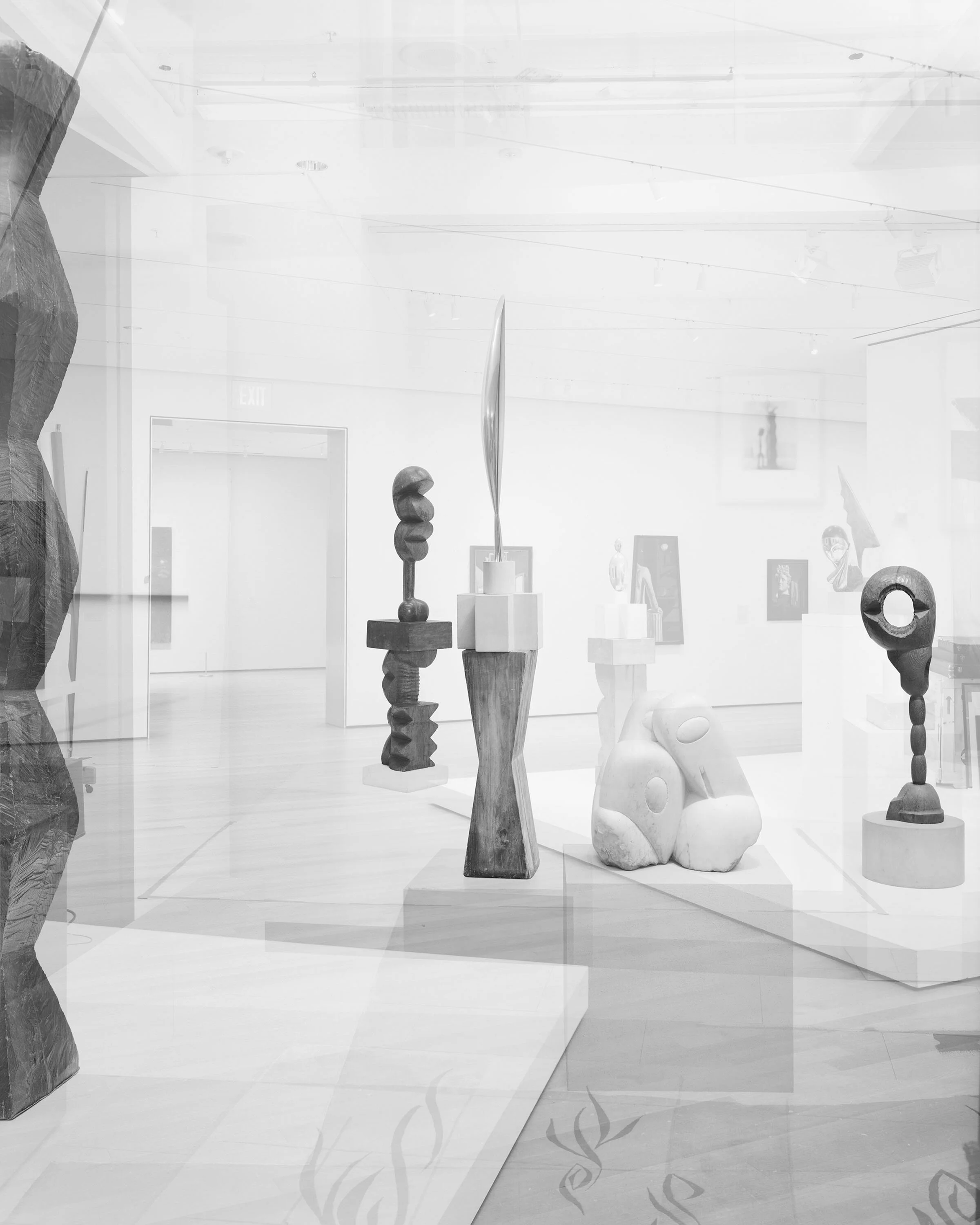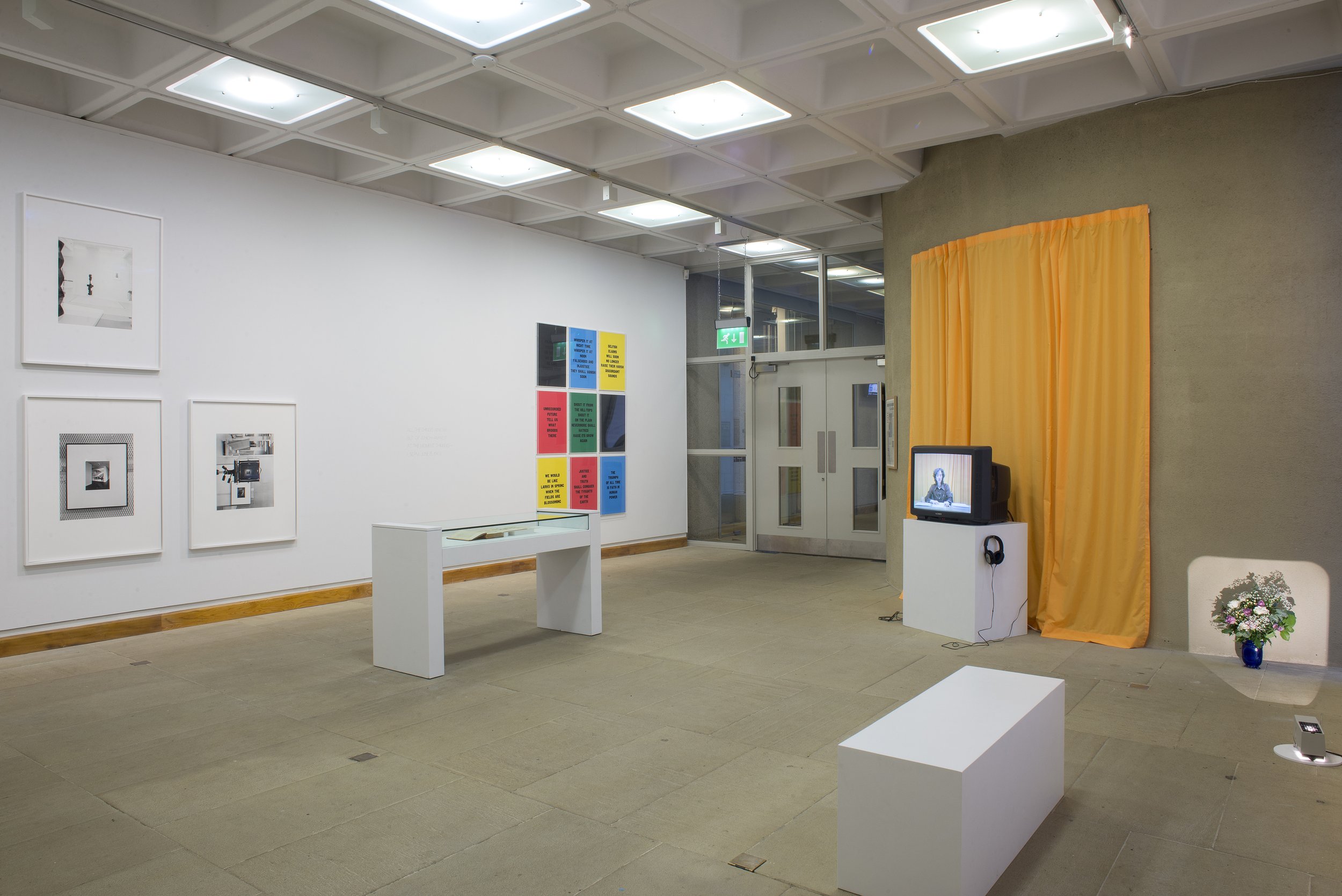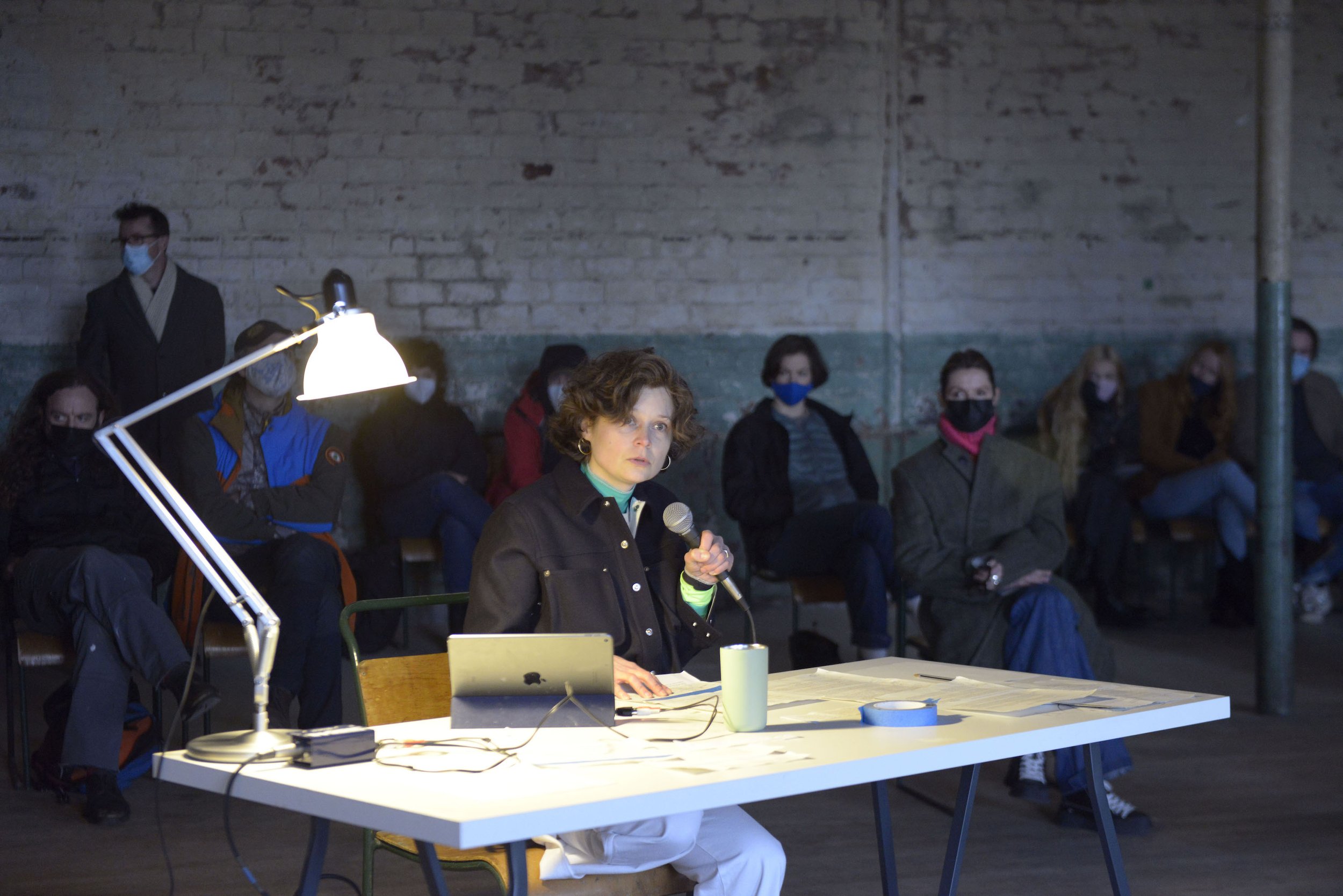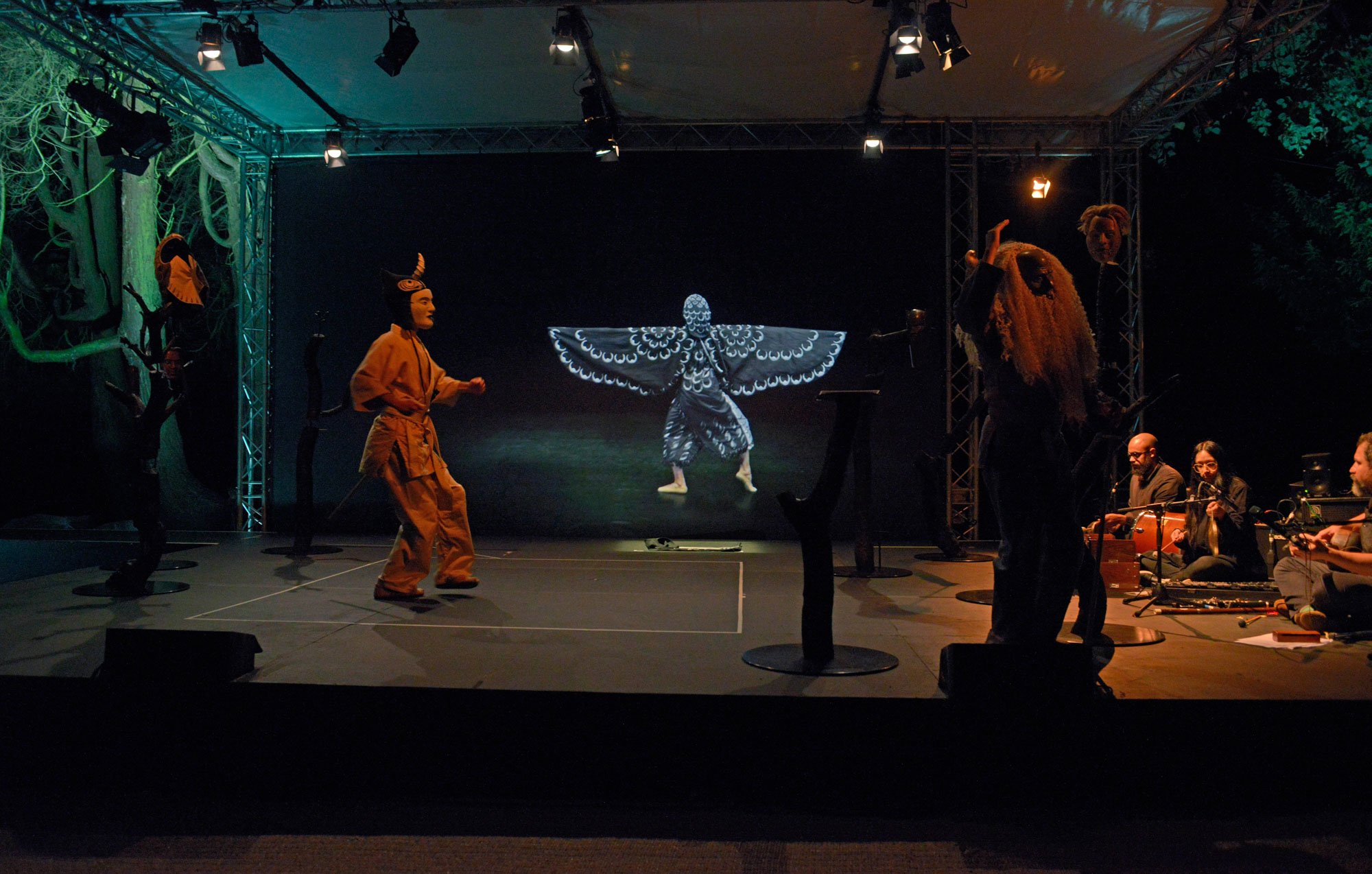
'A Synchronology: the contemporary and other times' – Robert Barry, Gerard Byrne, Phil Collins, Ruth Ewan, Sharon Hayes, Simon Starling, Corin Sworn and others
Simon Starling, 'Pictures for an Exhibition' 2013-2014. #12 of 36 Constantin Brancusi, Endless Column (1918), Adam & Eve (1916–21), Bird in Space (1926), Three Penguins (1911–12), Socrates (1922) (left to right).
Courtesy the Artist and The Modern Institute/Toby Webster Ltd, Glasgow.
Curated by Dr Dominic Paterson for the the University of Glasgow’s Hunterian Art Gallery, ‘A Synchronology’ is a new exhibition marking The Common Guild's 10th anniversary.
Taking its cue from the programme of exhibitions and projects we have realised since coming into being in 2007, the exhibition features several leading international artists and includes a diverse range of works that nonetheless share an interest in temporality: in marking time and in the presence of the past.
In our ten-year existence, The Common Guild has established itself as a leading force in contemporary visual arts in the UK. We curated Scotland’s participation in the 55th Venice Biennale in 2013, commissioning work by Corin Sworn, Hayley Tompkins and Duncan Campbell, who subsequently won the Turner Prize. The Common Guild has also worked closely with the University of Glasgow to present artist’s talks, symposia and other events, and ‘A Synchronology’ extends this collaboration.
The exhibition includes works by Robert Barry, Gerard Byrne, Phil Collins, Ruth Ewan, Sharon Hayes, Simon Starling and Corin Sworn and among others.
Further info
Supported by
Related

Roundtable Conversation / Kate Temple, Carrie Skinner & Isabella Shields on Simon Starling
Image: Installation view of ‘At Twilight’, Simon Starling, 2016. Photography by Ruth Clark.
Roundtable Conversations offer an opportunity to develop various ideas prompted by exhibitions at The Common Guild. This event focused on the work of Simon Starling and his exhibition 'At Twilight’ and includes contributions from artist, theatre designer & educator Kate Temple, artist & producer Carrie Skinner, and writer & art history student, Isabella Shields.
Event Details
Roundtable Conversations are free to attend and limited to a capacity of ten participants. Attendees are encouraged to participate in the discussion. Refreshments and light snacks are available.
Related

Simon Starling – 'At Twilight: A play for two actors, three musicians, one dancer, eight masks (and a donkey costume)'
Simon Starling, 'At Twilight / The Hawk's Dance' (Choreographed by Javier De Frutos in association with Scottish Ballet) (2016). Courtesy of the artist and The Modern Institute/Toby Webster Ltd, Glasgow.
'At Twilight: A play for two actors, three musicians, one dancer, eight masks (and a donkey costume)’, by Simon Starling in collaboration with theatre director Graham Eatough, is presented for three nights at Holmwood House, a National Trust of Scotland property on the south side of Glasgow. The play forms part of a project developed by Starling over the last three years and accompanies the exhibition 'At Twilight' at The Common Guild.
Simon Starling in collaboration with Graham Eatough. 'At Twilight: A play for two actors, three musicians, one dancer, eight masks (and a donkey costume)' 2016. Photo: Alan Dimmick.
The exhibition includes a collection of material that relates to nine characters, some real, some fictional, all interconnected by Starling. 'At Twilight: A play for two actors, three musicians, one dancer, eight masks (and a donkey costume)’ references ‘At The Hawk’s Well’, a play by W.B. Yeats that was written and performed 100 years ago, in the midst of the First World War, when he was working with the poet Ezra Pound.
The performance makes use of masks made in collaboration with Yasuo Miichi and costumes made in collaboration with Kumi Sakurai and Atelier Hinode that form part of the exhibition. It also includes 'The Hawk's Dance' – specially devised by renowned choreographer Javier de Frutos, working with Scottish Ballet and dancer Thomas Edwards – presented on film and accompanied by live music from Chicago-based musician Joshua Abrams and Natural Information Society.
Holmwood House is a historic property owned by conservation charity the National Trust for Scotland. Described as Alexander 'Greek' Thomson's finest domestic design, it was built in 1857-8 for James Couper, a local businessman. The house is an echo of the context in which the original Yeats play was presented – a large private home in Cavendish Square, London – while the grounds offer a remarkable background reminiscent of the forest setting that recurs throughout the piece, both in the blasted landscape backdrop of WWI and the Ashdown Forest setting in which Yeats and Pound worked together. The performance includes an opportunity to experience the heritage of this remarkable property and its grounds.
Simon Starling (born 1967 in Epsom, Surrey, lives and works in Copenhagen). His work has been shown worldwide including many significant international exhibitions such as the 50th and 53rd Venice Biennales in 2003 and 2009 respectively. Recent solo exhibitions include Nottingham Contemporary and Backlit, Nottingham, and ‘Reset Modernity!’, ZKM Museum for Contemporary Art, Karlsruhe (all 2016), ‘Metamorphology’ Museum of Contemporary Art, Chicago (2014) and Musée d'art contemporain, Montréal (2015).
Starling completed the MFA course at The Glasgow School of Art in 1992 and from 1993 to 1996 he was a committee member of Transmission Gallery, Glasgow. Starling was Professor at the Städelschule, Frankfurt am Main, from 2003 to 2013, and in 2005 he was awarded the Turner Prize.
Graham Eatough (b. 1971, Blackburn, lives and works in Glasgow) is a theatre maker who also works in visual arts and film. His most recent projects include directing 'Lanark: A Life in Three Acts' for the Edinburgh International Festival and the Citizens Theatre, Glasgow which won the Herald Angel Award, 'HeLa' by Adura Onahsile which won Scottish Arts Club Best Scottish Production at the Edinburgh Fringe, and 'The Making of Us', an interdisciplinary collaboration with artist Graham Fagen for Glasgow International Festival of Visual Art 2012. The film of 'The Making of Us' premiered at the Edinburgh International Film Festival 2013. Eatough was co-founder of Suspect Culture.
Venezuelan choreographer Javier De Frutos has received a great number of accolades including the 1995 Paul Hamlyn Award, 1996 Bagnolet Prix d’ Auteur, 1997 South Bank Show Award, 2004 Time Out Live Award and the 2005 Critics Circle National Dance Award for Best Choreography. His collaboration with Pet Shop Boys for The Most Incredible Thing earned Javier the 2011 Evening Standard Theatre Award, and a Critics Circle Best Choreographer nomination in 2012. Javier is a 5 time Olivier Award nominee and won the 2007 Olivier Award for Best Theatre Choreographer for his work on the musical Cabaret. Javier’s work is in the repertoire of leading dance companies including the Rotterdam Dance Group, Rambert Dance Company, the Royal New Zealand Ballet and Scottish Ballet.
The National Trust for Scotland is an independent charity set up in 1931 for the preservation and conservation of natural and human heritage that is significant to Scotland and the world. The Trust has gone on to become Scotland's largest membership organisation and a leader in conserving and promoting the nation's treasured places and collections so that they can be enjoyed by present and future generations.
Scottish Ballet is Scotland’s national dance company and presents a wide range of high-quality dance to audiences across Scotland, the UK and abroad. The Company has a long-standing interest in collaborating with artists, including most recently Martin Boyce and Rosalind Nashishibi.
Joshua Abrams developed his voice in the rich ferment of the 1990s Chicago music world, participating heavily across the city’s jazz, experimental & rock scenes. Over the last two decades he has recorded and toured with a wide range of artists including extended engagements with Fred Anderson, Bonnie ‘Prince’ Billy, Hamid Drake, Theaster Gates, Neil Michael Hagerty, Nicole Mitchell, Jeff Parker, Mike Reed, Matana Roberts, and The Roots. A film composer, Abrams has scored the music for five feature length films including the award-winning films Life Itself, The Interrupters and The Trials of Muhammad Ali.
Since 2011 Abrams has toured North America and Europe with a shifting-line up of musicians as ‘Natural Information Society’, which was assembled around his interests in the Moroccan instrument the guimbri. The band's most recent album, Magnetoception, was selected by The Wire Magazine as the #3 record of 2015 & by Pitchfork as the #2 experimental record of 2015. The group uses traditional and conventional instrumentation to create long-form intricately psychedelic environments, composed and improvised, which join the hypnotic qualities of Gnawa guimbri music to a wide range of contemporary musics and methodologies including jazz, minimalism and krautrock.
Abrams has collaborated with Simon Starling on previous works including 'El Eco' (2014).
Simon Starling in collaboration with Graham Eatough. 'At Twilight: A play for two actors, three musicians, one dancer, eight masks (and a donkey costume)' 2016. Photo: Alan Dimmick.
Further Info
Documents
Joyce McMillan reviews 'At Twilight: A play for two actors, three musicians, one dancer, eight masks (and a donkey costume)', The Scotsman, August 2016
Chris Sharratt reviews 'At Twilight: A play for two actors, three musicians, one dancer, eight masks (and a donkey costume)', Frieze, September 2016
Additional Links
Japan Society
The National Trust for Scotland
Scottish Ballet
Joshua Abrams
Project Details
'At Twilight: A play for two actors, three musicians, one dancer, eight masks (and a donkey costume)’, 2016 was presented from 26-28 August at Holmwood House, Glasgow.
Credits
‘At Twilight’ was commissioned by The Common Guild in collaboration with the Japan Society, New York.
Script by Simon Starling and Graham Eatough
Directed by Graham Eatough
Choreography by Javier De Frutos and Scottish Ballet
Music by Joshua Abrams and Natural Information Society
Performers: Adam Clifford and Stephen Clyde
Musicians: Joshua Abrams and Natural Information Society.
Costumes made by Kumi Sakurai and Atelier Hinode Tokyo, Japan.
Masks by Yasuo Miichi, Osaka, Japan
Blast tree made by Simon Hopkins/Scott Associates Sculpture and Design, Glasgow.
Shop / Buy ‘At Twilight’ –
Related

Exhibition Talk / Dr. Evelyn Silber, 'Gaudier-Brzeska and Ezra Pound - friendship and inspiration in the pre-1914 London avant-garde'
Simon Starling in collaboration with Graham Eatough. 'At Twilight: A play for two actors, three musicians, one dancer, eight masks (and a donkey costume)' (2016). Photo: Alan Dimmick.
As part of the context for Simon Starling's 'At Twilight', Dr. Silber talks about sculptor Henri Gaudier-Brzeska and his peers in the early 20th century. The brilliant young sculptor, Henri Gaudier-Brzeska, formed a close friendship with Ezra Pound in 1913-14, creating a monumental portrait in stone on which Starling’s mask of Ezra Pound is based. With Wyndham Lewis, they were the provocative leaders of the Vorticist group. When Gaudier-Brzeska was killed in 1915, Pound published a memoir of his work just a year later. This talk explores their relationship and the wider context of the pre-war literary and artistic avant-garde in London.
Dr. Evelyn Silber is Honorary Professorial Research Fellow (History of Art) at the University of Glasgow. She is a former Director of the Hunterian, University of Glasgow, also of Leeds Museums and Galleries, and Assistant Director at Birmingham Museums and Galleries. Evelyn has lived in Glasgow for over 14 years and is involved in several local heritage and cultural tourism projects.
Event Details
Listen to Dr. Evelyn Silber –
Related

Simon Starling – 'At Twilight'
Simon Starling, 'At Twilight' (Production Drawing), (2016). Courtesy of the artist and The Modern Institute/Toby Webster Ltd, Glasgow.
‘At Twilight’ is an ambitious new project by Simon Starling, developed in collaboration with theatre director Graham Eatough, which revolves around a WB Yeats play, ‘At the Hawk’s Well’. Imagined as a play, the project first takes form as an exhibition, presenting the rich array of associations and remarkable stories.
‘At the Hawk’s Well’ was written and performed in April 1916 in what Starling describes as “an odd cross-cultural mash-up in an English garden, at a traumatic moment in European history”. The play was written by Yeats while working with poet Ezra Pound and was inspired by traditional Japanese ‘Noh’ theatre. It is a fusion of Irish folklore and what Yeats then saw as an exciting new possibility for theatre.
Simon Starling, 'At Twilight', installation view, The Common Guild, 2016. Photo: Ruth Clark.
‘At Twilight’ encapsulates this dynamic discourse between tradition and the avant-garde, in a kind of absurd, dramatised tussle between history, mythology and Modernism. The inventions and innovations of Modernism have long been a source of interest for Starling, as has the trans-national movement of the people and ideas that shaped cultural history.
Extending from the core of the play through the circumstances of its coming into being, ‘At Twilight’ weaves together some surprising and significant inter-connections of influential figures and works through a particular time and place. This first presentation of Starling’s project coincides with the centenary of the play’s first appearance, in the middle of the First World War.
The exhibition at The Common Guild includes a group of masks and costumes for a performance, at the heart of which sits an imagined dialogue between Ezra Pound and W.B. Yeats, to be enacted as a fencing duel (as well as introducing him to ‘Noh’ theatre, Pound taught Yeats to fence). Starling’s masks, made by Japanese master mask-maker, each represent one of a range of inter-connected characters, both real and fictional. The nine characters represented include Yeats and Pound, as well as the 3 characters that appear in the original Yeats play, including and building on a work realised by Starling for the Yokohama Triennale in 2014 ‘At the Hawk’s Well (Grayscale)’, described as ‘Three costumes designed by Edmund Dulac and Michio Ito for the 1916 London premier of W.B. Yeats’ Noh-inspired play for dancers At the Hawk’s Well, reproduced in a grayscale palette using available historical documentation’.
Alongside Yeats, Pound and the fictional characters are: Nancy Cunard (1896 - 1965), daughter of the host of the 1916 performance and an heir to the Cunard Line shipping business; Michio Ito (1892 - 1961), a Japanese dancer who played The Hawk in the 1916 performance and went on to work with Martha Graham later in his career; Jacob Epstein’s ‘Rock Drill’ (1913 - 14), probably the sculptor’s most radical work, a fore-boding man-machine that first came into being before the start of WWI but was radically amended in 1916; and Eeyore, the famously glum donkey from A.A. Milne’s ‘Winnie the Pooh’ stories (first appearing 1926), set in the same Ashdown Forest where Yeats and Pound spent the winters of 1913-16, represented here in the form of a pantomime donkey costume for two actors.
The backdrop of the war and its devastation is evoked in the exhibition by a group of ‘blast trees’. These highly figurative stands, on which Starling exhibits the masks, take the form of charred, black tree trunks, echoing the ‘blasted landscapes’ of WWI.
‘At Twilight’ includes a danced segment - presented as film in the exhibition - devised specially by renowned choreographer Javier de Frutos, working with Scottish Ballet and dancer Thomas Edwards using the ‘grayscale’ Hawk costume. The music for the Hawk’s dance was created by Chicago-based musician Joshua Abrams and the Natural Information Society.
Further Info
Additional Links
Laura Campbell, ‘Simon Starling - At Twilight Review’, The Sunday Times, July 2016
‘At Twilight – Review’, The Scotsman, July 2016
Chris Sharratt reviews 'At Twilight: A play for two actors, three musicians, one dancer, eight masks (and a donkey costume)', Frieze, September 2016
Documents
Supported by
Creative Scotland, Sylvia Waddilove Foundation, Outset Scotland and the Japan Society of the UK.
Project Details
‘At Twilight’ was commissioned by The Common Guild in collaboration with the Japan Society, New York.
Credits
Choreography by Javier De Frutos and Scottish Ballet
Music by Joshua Abrams and Natural Information Society
Costumes made by Kumi Sakurai and Atelier Hinode in Tokyo, Japan
Masks made by Yasuo Miichi, Osaka, Japan
The exhibition 'At Twilight' was also presented at the Japan Society Gallery, New York, in October 2016.
Read the Commentary by Isabella Shields –
Engagement –
Artist and theatre designer Kate Temple led a series of workshops focusing on ‘At Twilight’. The sessions explored the cross-disciplinary nature of the exhibition and ways of approaching art practice and collaboration.
Related

Room for Reading / 2016
Room for Reading features publications about and selected by exhibiting artists in our programme.
Throughout 2016, our Room for Reading selections feature publications chosen and inspired by Ulla von Brandenburg, Akram Zaatari, Simon Starling and Sharon Hayes, artists we are working with on current and upcoming projects.
Ulla von Brandenburg: Whose beginning is not, nor end cannot be’ (2008); Innen ist nicht Außen (Inside is not Outside) (2013) ; and Formerly Elentiere (2008)
In advance of Ulla von Brandenburg’s performance ‘Sink Down Mountain, Rise Up Valley’ at Langside Halls on the 30th and 31st of January, we have selected three publications on the artist’s work.
‘Whose beginning is not, nor end cannot be’ was published on the occasion of Von Brandenburg’s exhibition at the Irish Museum of Modern Art in Dublin in 2008. The publication features essays by Declan Long and Beatrix Ruf, as well as an interview between the artist and Rachel Thomas.
‘Innen ist nicht Außen (Inside is not Outside)’ was published in 2013 to accompany an exhibition of the same name at Vienna Secession. It features texts by Nina Möntmann, András Pálffy, Annette Südbeck and René Zechlin.
‘Ulla Von Brandenburg. Formerly Elentiere’ (2008) was published following the exhibition, ‘Where a red net lies over the green’ at the Kunstverein für die Rheinlande und Westfalen, Düsseldorf, 2008, and features texts by Nina Möntmann and Vanessa Joan Müller.
Antoine Picon, ‘The Saint-Simoniens: Reason, Imagination and Utopia’ (2002)and Ralph P. Locke ‘Music, Musicians and the Saint-Simonians’ (1986).
Von Brandenburg selects ‘The Saint-Simoniens: Reason, Imagination and Utopia’ by Antoine Picon (2002), in which Picon discusses Saint-Simonianism, an influential utopian movement in 19th Century France, paying special attention to Saint-Simonian ideas about architecture and public space.
Von Brandenburg’s second selection Music, Musicians and the Saint-Simonians’ (1986) by Ralph P. Locke outlines Saint-Simonian approaches to music as an ideological tool.
Read ‘The Saint-Simoniens: Reason, Imagination and Utopia’ here.
Akram Zaatari, ‘Akram Zaatari: A Conversation with an Imagined Israeli Filmmaker Named Avi Mograbi’ (2012); ‘Time Capsule, Kassel 24/25.05.2012’ (2013), 'Film as a Form of Writing: Quinn Latimer talks to Akram Zaatari’ (2014).
As Akram Zaatari, ‘The End of Time’ opens at 21 Woodlands Terrace, the artist has made a selection of books to accompany the exhibition.
The first is 'Akram Zaatari: A Conversation with an Imagined Israeli Filmmaker Named Avi Mograbi’ published by Sternberg Press, 2012. During a residency at Les Laboratoires d'Aubervilliers, Zaatari attempted to write, improvise, and deliver a conversation with an imagined Israeli filmmaker, giving him the name Avi Mograbi. Zataari used this fictional character as a device to revisit photographs he made during the Israel occupation of his hometown in 1982, imagining what could have been experienced by an Israeli filmmaker in this time.
'Akram Zaatari: Time Capsule, Kassel 24/25.05.2012' is a postscript to the exhibition 'This Day at Ten' at MAGASIN - Centre National d'Art Contemporain de Grenoble, 2013. Inspired by an act of conservation that the founder of the National Museum in Beirut undertook on the eve of the civil war in 1975–6, ‘Time Capsule, Kassel’ is, in the artist's words, a statement about speculation, photography, time and withdrawal.
'Film as a Form of Writing: Quinn Latimer talks to Akram Zaatari’ (2014) is an in-depth interview between the artist and critic Quinn Latimer. In the interview Zaatari describes his work: “as with most of my work, it is made for time; it is both a testimony of where I come from and a mark I care to leave for the future—again as thought, not as data or records. Let’s call it alternative writing that uses the form of letters.”
Read Quinn Latimer on Akram Zaatari in Artforum here.
Watch a short film by Akram Zaatari about ‘Time Capsule, Kassel’ here.
Karl Bassil, Zeina Maasri and Akram Zaatari, 'Mapping Sitting: On Portraiture and Photography'(2002)'; Karl Bassil and Akram Zaatari, ‘'EARTH of ENDLESS SECRETS' (2009); Akram Zaatari, All Is Well' (2014)
Zaatari also selects 'Mapping Sitting: On Portraiture and Photography' by Karl Bassil, Zeina Maasri, and Akram Zaatari (2002) which accompanied the eponymous exhibition curated by Walid Raad and Zaatari from the Arab Image Foundation. Featuring photographs taken between the 1920s and the 1970s, in Lebanon, Egypt, Iraq, Palestine and Jordan, it raises questions about portraiture, performance, photography and identity in the Arab world.
'EARTH of ENDLESS SECRETS' by Karl Bassil and Akram Zaatari (2009) examines Zaatari’s ongoing research project, unearthing and examining a wide range of documents that testify to the current cultural and political conditions of Lebanon.
Akram Zaatari’s 'All Is Well' (2014), published on the occasion of the artist’s first solo exhibition in Canada, addresses the complex history of the civil conflict in Lebanon. The publication explores the precarious status of archives in times of war, as well as their discursive limits as narrators of Lebanon’s history.
Read an interview with Zaatari on ‘Mapping Sitting’ published by MoMA here.
Watch a selection of excerpts from Zaatari’s films on Video Data Bank here.
Watch Zaatari speak about photography, memory and here.
Etel Adnan, ‘Sitt Marie-Rose’ (1982); Jibrail S. Jabbur, ‘The Bedouins and The Desert:Aspects of Nomadic Life in the Arab East’ (1995); Ariella Azoulay ‘From Palestine to Israel: A photographic Record of Destruction and State Formation, 1947-1950’ (2011).
In the final instalment of Akram Zaatari’s Room for Reading selections, the artist selects authors and critical works that describe aspects of Arab life.
'Sitt Marie-Rose (A Novel)' by Etel Adnan (1982) is set before and during the 1975-1990 Lebanese Civil War, and based on the life of Marie Rose Boulos who was executed by a Christian militia during the long conflict.
'The Bedouins and The Desert: Aspects of Nomadic Life in the Arab East' by Jibrail S. Jabbur (1995) is an extensively illustrated account of traditional bedouin life in the Arab east which recounts the history of the enigmatic Slayb tribe.
'From Palestine to Israel: A photographic Record of Destruction and State Formation, 1947-1950' by Ariella Azoulay, a photo book in which Azoulay reconstructs the processes by which the Palestinian majority in Mandatory Palestine became a minority in Israel.
Sonallah Ibrahim , ‘Zaat’ (2011); Jacques Derrida, ‘Archive Fever’ (1995).
Sonallah Ibrahim’s 'Zaat'(2001) tells the story of an Egyptian woman – the eponymous Zaat – during the regimes of three Egyptian presidents: Abdel Nasser, Sadat, and Mubarak.
'Archive Fever: A Freudian Impression' by Jacques Derrida (1995), a deconstructive analysis of the notion of archiving and an extended meditation on remembrance, religion, time, and technology, including the e-mail.
Read ‘Sitt Marie Rose’ here.
Read an excerpt from 'The Bedouins and The Desert: Aspects of Nomadic Life in the Arab East' here.
Listen to a talk by Ariella Aisha Azoulay ‘On Photography and Potential History’ here.
Read ‘Archive Fever: A Freudian Impression’ here.
Ezra Pound, ‘A Memoir of Gaudier-Brzeska’ (1970); David R. Clark, ‘W.B. Yeats & the Theatre of Desolate Reality’ (1965); Nobuko Tsukui, ‘Ezra Pound and the Japanese Noh Plays’ (1983).
To coincide with Simon Starling’s exhibition ‘At Twilight’, the artist has selected the following books for this month’s Room for Reading.
'A Memoir of Gaudier-Brzeska' (1970) by the modernist poet and writer Ezra Pound was first published in 1916. The 1970 edition brings together Pound’s original text with later writing on Henri Gaudier-Brzeska, the French sculptor with whom Pound had a friendship before the former was killed in World War One. Pound was a huge champion of Gaudier’s work and raised the profile of the artist both during his life and after his death.
'W.B. Yeats & the Theatre of Desolate Reality' (1965) by David R. Clark illustrates Yeats’ development as a dramatist, through close examination of four of the modernist poet, playwright and writer’s plays.
Starling has chosen two books on Noh Theatre, a Japanese form of dance-drama that has been performed since the 14th Century. 'Ezra Pound and Japanese Noh Plays' (1983) by Nobuko Tsukui, and 'The Noh Theatre of Japan' (1959) by Ernest Fenollosa and Ezra Pound. Starling has also selected 'A Guide to Kyogen' (1968) by Don Kenny, a book designed as a basic guide for the viewer of a Kyogen performance containing synopses of all the plays in the present repertoire of the Kyogen practice.
'Stone Cottage: Pound, Yeats & Modernism' (1988) by James Longenbach details the period between 1913-16 during which W.B Yeats developed his autobiographies and Noh-style plays with the help of Ezra Pound.
Finally, Starling selects 'Four Plays for Dancers' (1921) by W.B.Yeats, which includes 'At the Hawks Well' a play by that was written and performed 100 years ago and is at the heart of Simon Starling and Graham Eatough’s ‘At Twilight: A play for two actors, three musicians, one dancer, eight masks (and a donkey costume)’.
Read ‘A Memoir of Gaudier-Brzeska' here and read more about Yeats and Brzeska here.
Read ‘The Collected Plays of W.B. Yeats’ (1963) published by MacMillan here.
Sharon Hayes
Francesco Bonami and Gary Carrion-Murayari, ‘2010’ (2010); ‘Sharon Hayes, ‘There’s So Much I Want To Say To You’ (2012) ; ‘Il Palazzo Enciclopedico’ (2013).
As Sharon Hayes’ exhibition 'In My Little Corner of the World, Anyone Would Love You’ opens to the public, we have selected three publications that focus on the artist’s earlier work.
Sharon Hayes, 'There's So Much I Want To Say To You' (2012) was published in conjunction with Hayes eponymous exhibition at the Whitney Museum of American Art in 2012 which brought together works, all of which articulate forms of what Hayes calls “speech acts”.
Hayes’ ‘Ricerche: three’ (2013) was commissioned and presented as part of ‘Il Palazzo Enciclopedico’ (The Encyclopedic Palace) curated by Massimiliano Gioni on the occasion of the exhibition at the 55th International Art Exhibition of La Biennale di Venezia. The catalogue is included here.
Our final recommendation is the catalogue accompanying the 2010 Whitney Biennial, titled ‘2010’, curated by Francesco Bonami and Gary Carrion-Murayari, in which Hayes’ work ‘Parole’ (2010) was included.
Read more about ‘There’s So Much I Want To Say To You’ here.
Read Massimiliano Gioni’s curatorial text for ‘Il Palazzo Enciclopedico’ here.
Read more about ‘Parole’ and ‘Ricerche: three’ in an essay by Julia Bryan-Wilson for Afterall Journal here.
Renate Lorenz, ‘Queer Art: A Freak Theory’ (2012)'; Andrea Geyer and Sharon Hayes, ‘History Is Ours’ (2009); Sharon Hayes, ‘After Before - in the near future’ (2008).
Sharon Hayes recommends 'Queer Art: A Freak Theory' (2012) by Renate Lorenz. Lorenz’s book develops a queer theory of visual art based on extensive readings of art works and theoretical debates combining queer theory with post-colonial theory, and (dis-)ability studies, proposing the three terms: “radical drag”, “transtemporal drag”, and “abstract drag”.
Hayes also selects 'History Is Ours' (2009) by Andrea Geyer and Sharon Hayes, published by Kunst Museum St. Gallen and Kehrer Verlag Heidelberg to accompany a collaborative exhibition of the same name. The publication features transcripts and documentation of the artists’ work as well as conversations with Yvonne Rainer and Wu Tsang.
Lastly, 'After Before - in the near future’ (2008) by Sharon Hayes which documents Hayes’ project ‘After Before’, a multi-channel video installation developed during a studio residency at the Lower Manhattan Cultural Council in 2004.
Read an excerpt from ‘Queer Art: A Freak Theory’ here.
Read ‘History Is Ours’ here.
Read ‘After Before – in the near future’ here.
Details
Room for Reading is a space to engage with research related to our programme as recommended by the artists and collaborators we work with at The Common Guild.
Books are suggested in conjunction with our exhibitions and projects.
Related

Primer / Simon Starling
Simon Starling, ‘At Twilight’ installation view, The Common Guild, 2016. Photo: Ruth Clark
In advance of a major new commission for The Common Guild in 2016, artist Simon Starling talked about the development of his work as part of our 'Primers' series.
Starling is known for his works that investigate global inter-connections through people, and the histories and narratives that become imbued in objects. His new project, in development with theatre director Graham Eatough, will comprise live performance and an exhibition of associated material, and revolves around an attempt to stage a performance of WB Yeats’ play ‘At the Hawk’s Well’, first performed in 1916 and inspired by traditional Japanese ‘Noh’ theatre.
Simon Starling (b.1967 in Epsom, England) lives and works in Copenhagen, Denmark. He began his career in Glasgow, having studied on the MFA at The Glasgow School of Art. He was the winner of the 2005 Turner Prize and has been the subject of many major international museum exhibitions over the past decade. Until recently, he was a Professor at the Städelschule in Frankfurt.
Event Details
‘Primers' offer an opportunity to hear from artists developing projects with The Common Guild and are presented in collaboration with the University of Glasgow.

















































